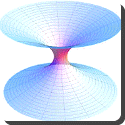 A wormhole is a theoretical entity allowed by Einstein’s theory of general relativity in which spacetime curvature connects two distant locations (or times). The term ‘wormhole’ was coined by American theoretical physicist John A Wheeler in 1957, based on an analogy of how a worm could chew a hole from one end of an apple through the centre to the other, thus creating a shortcut through the intervening space.
A wormhole is a theoretical entity allowed by Einstein’s theory of general relativity in which spacetime curvature connects two distant locations (or times). The term ‘wormhole’ was coined by American theoretical physicist John A Wheeler in 1957, based on an analogy of how a worm could chew a hole from one end of an apple through the centre to the other, thus creating a shortcut through the intervening space.
Learn More:
A wormhole is a hypothetical spacetime topology, a “shortcut” that would allow travel between two points at apparently faster-than-light speeds. The name comes from analogizing spacetime to the surface of an apple, in which a wormhole is a tunnel through the apple. In reality, movement through a wormhole would not be faster-than-light, but rather moving at normal speed through folded space.
Wormholes are popular in science fiction because they allow characters to travel great distances in short periods of time. In real life, wormholes probably do not exist, as they would require negative matter, an exotic substance that has never been observed and whose existence is not predicted by the Standard Model of particle physics. Mathematical models of wormhole spacetimes show that they would “pinch off” almost instantaneously. In addition, a wormhole would have to be extremely small — most models show wormholes with openings smaller than an atomic nucleus.
Wormholes have also been called Schwarzschild wormholes or Einstein-Rosen bridges, in the context of past mathematical analyses. An Einstein-Rosen bridge would have a black hole at both entrances, which means that once a theoretical traveler entered into the wormhole, they would cross an event horizon and be stuck in the middle.
If wormholes could exist, they could also function as time machines. According to Einstein’s theory of relativity, time passes more slowly for a highly accelerated body. If one end of a wormhole were accelerated to close to the speed of light while another were stationary, a traveller entering into the stationary hole would emerge in the past from the accelerated hole. This type of wormhole would be called a closed timelike curve or a timehole.
Physicist Stephen Hawking has proposed that the causality-breaking properties of such wormholes would be physically forbidden by a form of cosmic censorship. This is because time travel would cause apparently irresolvable paradoxes, such as a case in which someone goes back in time to kill their earlier self. Learning more about the theoretical properties of a wormhole would require a quantum theory of gravity, which has not yet been developed.
 Kids Portal For Parents India Kids Network
Kids Portal For Parents India Kids Network






